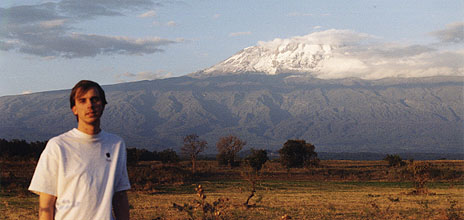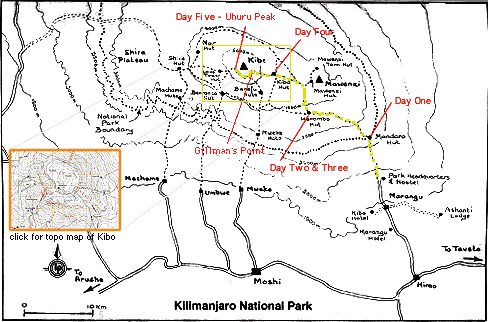

Okay, so it's like there's this volcanic mountain in Tanzania.
And it's big.
In fact, at 5895 meters or
19,340 feet it also happens to be the highest point in Africa.
Which is of course why everybody's gotta try and climb it
-- including this daring group of intrepid explorers from REI Adventures:

Okay, from left to right in the
front row we've got Elaine from Seattle, Washington;
Bill from Tallapoosa, Georgia; Brad from New York; our fearless
Tanzania leader, Peter;
Laurie from Stevens Point, Wisconsin; and Elaine from Laramie,
Wyoming.
In the back is Jeff from El Segundo, California; myself from San
Jose, California;
Ruth from Waxahachie, Texas; Jim from Albuqerque, New Mexico; Cindy
from Muscatine, Iowa;
John from Houston, Texas; Cecilia from Torrance, California; Gary
from Houston, Texas;
Rosemary from Los Gatos, California; and Mary from Albuqerque, New
Mexico.
Mt. Kilimanjaro consists of
three volcanic cones: Shira, Mawenzi, and the highest: Kibo.
The most common route, the "tourist route", starts at the park
headquarters (1980 m) near Marangu.
This route first reaches the rim of the caldera of Kibo at Gillman's
point (5685 m)
and then it's another couple of long hours walking the rim of the
caldera
to the true summit, Uhuru peak, on the western slope at 5895
meters.

The climb to the top of
Kilimanjaro via the Marangu route is completely non-technical.
No ice-axes, no ropes, no crampons. So what's the big deal? Well,
it's the altitude and thus
the lack of oxygen and the lower air pressure and how this affects
your ability to exert yourself.
I found that after some practice peak climbs before I left for
Kilimanjaro
and after taking four days to acclimatize on the way, it really
was
"hakuna matata" (no problem) and fairly easy going as far as Kibo Hut
at 4700 m (15500 ft).
A mere five hundred feet later however, I started to get a headache
and later feel nauseous.
At the top, I suddenly got hit with everything and so rushed back
down the mountain
(after taking all the necessary photos of course).
Others were feeling ill much
earlier and in fact, other accounts I've read on the ascent
tend to sound pretty miserable -- like this account from a local
Sierra Club peak climbing group
entitled "People
Vomit With An Accent".
The most amusing account,
though poorly written, comes from the somewhat offical-looking
"Kilimanjaro Map & Guide"
which is actually sold at the Kilimanjaro park headquarters.
It begins like this:
What it's like climbing the moutain.
by Mark Savage
"First. Don't underestimate the mountain. Kilimanjaro is BIG and the whole exercise is HARD WORK!! Probably harder exercise than anything you've done since you left school or were in one of the services. You will probably be cold at some point. Worse, you may get soaking wet cold in the rain or sleet. At the higher altitudes you will almost certainly suffer a headache and may well feel sick/vomit. You will discover muscles you didn't know you even had and at time you will consider yourself a prime candidate for the lunatic asylum. But not to worry, this is quite normal on a mountain of just under 20,000 ft. Console yourself with the thought that most of the others with you feel the same way (and often worse than you), and that it can't go on forever. If you're still interested in climbing, below is a brief synopsis of how an average walker might expect to feel while ascending the mountain, though it is of course impossible to predict, how you the reader will feel and react.
Park gate to 3,000m. The first hour or so's walk is a novel experience. The scenery is interesting and if you left early, it is still quite cool. Pulse rate is between 100 - 120 pm and the breathing rate at about one cycle for every 3-4 steps. By 11:00 am it has started to warm up, so you are sweating a bit. The legs start to feel the strain of nonstop up-hill walking and the calf muscles ache. A sit-down breather every 30 - 40 minutes is welcome. Once reaching the first hut, (Mandara), a cup of tea/coffee revives you rapidly, and within an hour you feel almost normal.
3,000m - 4,000m. You should have slept very well and breakfast tasted great. You're somewhat stiff all over, but this soon wears off after you get walking. Again the ftrst hour or so up to the moorland is very pleasant, though after that the walk becomes a bit of 'a drag' as the scenery becomes more monotonous and unvarying. A couple of blisters are forming, one on the instep and another on the small toe, but what the hell! Pulse rate is similar to yesterday, but the pace of walking is definitely slower. Once at the hut, if you have not used sunglasses during the walk, a mild headache may occur. Appetite still OK for tasty foods but not too fatty. Leg cramps in the evening.
4,000m - 4,800m. You did not sleep as well as you might have expected. The headache got worse during the night but goes soon after breakfast. Fruit, bread and jam were fme,but the sausage and bacon were a definite no no! The blister that you should have attended to yesterday, (but couldn't be bothered to), is now taped up and feels a lot better. Again the first hour or so of walking is great, thereafter it's one step after the next. Around noon the Kibo Hut comes into sight, briefly seen through the mists. However, when seen again, it never seems to have gotten any closer. Soon it starts to sleet and hail, and the feeling of 'Why am I doing this' now gets asked aloud. Pulse is steady between 130-150 and you're taking a breath in as you put one foot down and breathing out on the next step and so it goes on and on and on.... At the Kibo Hut a drink goes down OK, but the mere thought of food is Ugh! Your head throbs just behind the eyes, you're cold, wet and miserable so to collapse into the sleeping bag, even though it's only 3:OO pm seems a great idea.
4,800m - Summit. Getting up at midnight isn't so bad, alter all you've not slept since some noisy sod woke you up by slamming the hut door at 8 that night. You've now put on all the cloths that you have but are still half frozen with the cold. The tea and biscuits you forced down earlier tasted foul, and after a half hours walking you bring them back up. Immediately you feel 100% better. Like the previous day it's again one foot after the next if it's frozen scree, or 2 up, slide back 1 if it is not frozen. Just before dawn you reach Gillman's point and your guide tells you that you've reached 'the top' (not quite true), and you thank him for his assistance in pushing you up the last 200m. Now you have a choice. Either you lie down and contemplate the walk back down though preferably you wish you could just die, or there's Uhuru Peak another hour and half onwards. Decisions, Decisions, Decisions. Should be illegal at this altitude.
Descending. The walk back to Gillinan's from Uhuru was pure hell, particularly the short sections of up-hill, however once leaving the crater rim you can noticeable feel the air getting thicker and heavier in the lungs with each meter of descent. Now that it's daylight you can see the full horror of the scree slope, and you wonder how anybody, let alone yourself, ever made it up it. You start to feel better, good even, particularly so as you pass several groups still struggling upwards. That night at Horombo you sleep the sleep of the grateful dead, though next morning it's a struggle to get out of your bag as every muscle hurts. From here the walk down is... well enough here. Find the rest out yourself."
Really, it's not that bad -- it's quite wonderful actually.
Micheal Crichton (author of
"Jurassic Park", etc) also makes the climb out to be pretty
unbearable
in his non-fiction book "Travels". On the other hand, it's pretty
clear from reading his book
that he's pretty pig-headed about not taking reasonable preparations,
advice, or help.
I also discovered that he exaggerates everything from the depth and
wear of the trail to the color of the sky.
I suppose that's why he's a best-selling author!
Go to my Kenya and Tanzania page